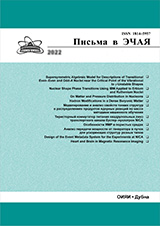Exploring Stopping Power Models for Efficient Ignition Condition in Inertial Confinement Fusion Driven by Fast Ignition Method
Ключевые слова:
stopping power models, inertial fusion, two-temperature model, proton fast ignitionАннотация
Fast ignition, a pivotal concept in inertial confinement fusion, presents a departure from conventional methods by implementing a two-stage process for fuel compression and ignition. This novel approach minimizes driver requirements and enhances energy efficiency. Among the primary solutions for initiating fast ignition, the utilization of light ion beams, specifically protons, generated through the interaction of high-power lasers with convertor foils, emerges as a prominent strategy. Investigation into the transport of alpha particles produced by the deuterium-tritium fusion reaction plays a vital role in the formation of a hot spot within the fast ignition framework. The self-heating effect caused by the energy deposition of alpha particles triggers ignition in the fusion fuel. Thus, this study focuses on exploring the impact of modern stopping power models, specifically BPS and MD, on the ignition criteria and hot spot formation of pre-compressed DT fuel using a two-temperature model in a non-equilibrium state. These new models are compared and contrasted with previous ones. For this investigation, a DT equimolar fuel with a density of 300 gcm-3 and an incident proton beam featuring an average energy of 4 MeV and a Maxwellian energy distribution are employed. Our calculations demonstrate that the newer BPS and MD stopping power models slightly shift the ignition criterion towards higher ρR values. Furthermore, the thermal efficiency reduction of alpha particles in these stopping power models leads to a significant decrease in hot spot temperature when compared to older models.




